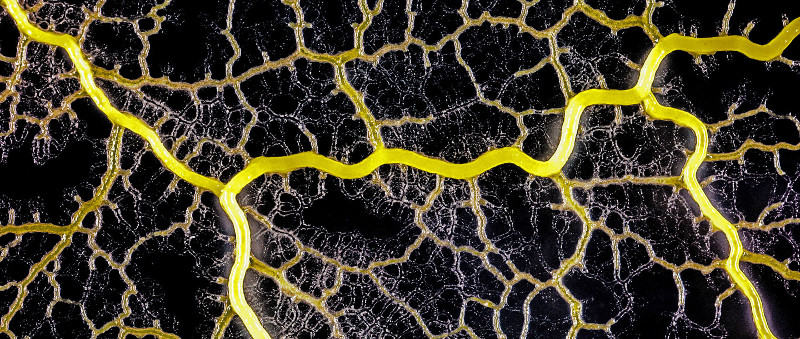Review: Life at the Edge of Sight
Life at the Edge of Sight by Scott Chimileski and Roberto Kolter is one of those rare books that makes a complex subject — microscopic organisms including bacteria, fungi, protozoans, viruses, phages, archaea — genuinely exciting and wondrous, not by over-simplifying it, but by illuminating it through brilliant photographs and lucid explanations.
You may have seen the authors’ photographic and micrographic work before, for example, in this Quanta article: The Beautiful Intelligence of Bacteria and Other Microbes. If you find the images stunning, the book provides the additional context to understand what’s going on. How and why do bacteria form biofilms, and how do they communicate with each other? What are mycelial networks, and how do they interact with plants? What exactly is a slime mold, anyway, and what makes these brainless creatures so smart?

The slime mold Physarum polycephalum. (Credit: Scott Chimileski and Roberto Kolter. Fair use.)
The book succeeds in conveying a view of the “web of life” that makes humans seem less like a pinnacle and more like one element in an ever-changing, ever-adapting network that transforms our planet both at the smallest and the largest scales. Moreover, life we may consider to be purely microscopic or single-celled often goes through macroscopic or multi-cellular stages.
To drive this point home, the authors include a chart that show the “size ranges” of different organisms, from individuals to collectives. The largest single living organism on Earth may well be a humongous fungus in Oregon— while human spermatozoa exist at the microbial scale.
The Verdict
This is a great book for anyone curious about the smallest dimensions of life. The list price of the hardcover edition as of this writing is $35; you will likely be able to get it for less. That’s a very reasonable price for a gorgeous, 370 page science book that’s also—for the most part—a great read.
If I have one criticism, it’s that the book goes into jargon-heavy explanations early on, which might deter some readers before they have a chance to really dive in. Here’s a quote from page 19:
Archaea, like the gram-positive bacteria, have one cell membrane, but the archael membrane is composed of different lipids than those in the bacterial membrane. Archael cell envelopes often also have an outer crystalline lattice of proteins called an S-layer.
Judging by some of that early writing, you might think the entire book is going to be highly technical, but it isn’t. For example, there’s an extensive description of the microbial life inside a block of cheese; the description is given in the form of an imaginary journey of an explorer who shrinks herself to the microscopic scale and gets into a fight with a cheese mite. In other words, this is a book that allows itself to have a little fun with its explanations.
The bumpy beginning is a minor concern, and I highly recommend this book regardless. If you do pick it up and don’t already have the domain expertise to parse the above quote, don’t give up too quickly; the writing becomes a lot more accessible in later chapters.
